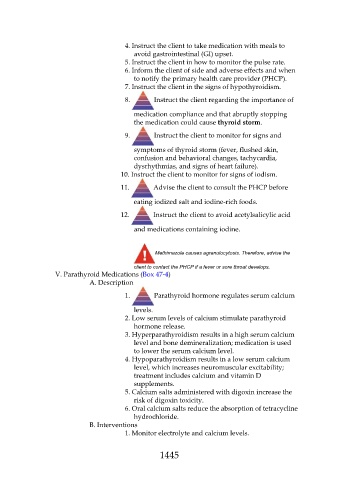Page 1445 - Saunders Comprehensive Review For NCLEX-RN
P. 1445
4. Instruct the client to take medication with meals to
avoid gastrointestinal (GI) upset.
5. Instruct the client in how to monitor the pulse rate.
6. Inform the client of side and adverse effects and when
to notify the primary health care provider (PHCP).
7. Instruct the client in the signs of hypothyroidism.
8. Instruct the client regarding the importance of
medication compliance and that abruptly stopping
the medication could cause thyroid storm.
9. Instruct the client to monitor for signs and
symptoms of thyroid storm (fever, flushed skin,
confusion and behavioral changes, tachycardia,
dysrhythmias, and signs of heart failure).
10. Instruct the client to monitor for signs of iodism.
11. Advise the client to consult the PHCP before
eating iodized salt and iodine-rich foods.
12. Instruct the client to avoid acetylsalicylic acid
and medications containing iodine.
Methimazole causes agranulocytosis. Therefore, advise the
client to contact the PHCP if a fever or sore throat develops.
V. Parathyroid Medications (Box 47-4)
A. Description
1. Parathyroid hormone regulates serum calcium
levels.
2. Low serum levels of calcium stimulate parathyroid
hormone release.
3. Hyperparathyroidism results in a high serum calcium
level and bone demineralization; medication is used
to lower the serum calcium level.
4. Hypoparathyroidism results in a low serum calcium
level, which increases neuromuscular excitability;
treatment includes calcium and vitamin D
supplements.
5. Calcium salts administered with digoxin increase the
risk of digoxin toxicity.
6. Oral calcium salts reduce the absorption of tetracycline
hydrochloride.
B. Interventions
1. Monitor electrolyte and calcium levels.
1445

